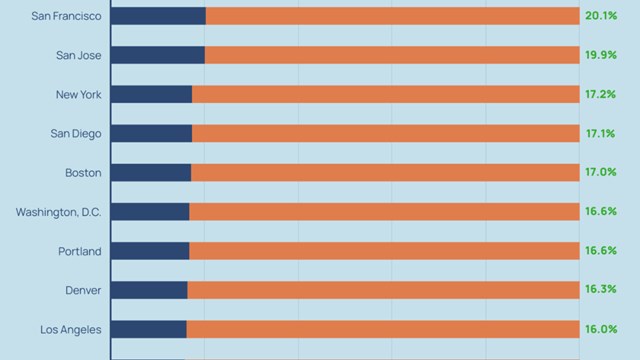Back in the days of irrational exuberance, co-op board directors would occasionally contact me to inquire about investing in stocks to achieve higher rates of return on reserve funds. I believed it was an unwise move then and my advice would be the same today.
A reserve fund represents money that a co-op sets aside for either planned capital improvements or as a safety net to cover unforeseen expenditures that can occur at any time. Accordingly, a co-op should treat its reserves as funds that may be needed in the very near future, for example, in one to two years. For this reason, a co-op should invest with capital preservation as the key investment objective.
A co-op board is comprised of volunteers who are voted to a board to make prudent decisions about general building operations, not for their investment expertise. If a board decides to take a more aggressive posture with its reserves by investing in equities and "hits a homerun" in the process, it is unlikely their shareholders will hold a party to congratulate them. Conversely, if a co-op had committed its reserve fund to the equity markets just prior to the bursting of the stock market bubble, and then, after the market tanked, there was a shortfall in the funds that were earmarked for a major capital project, the more likely response from the shareholders would be to "tar and feather" the board and send them out of town hanging from a rail.
With this in mind, how does a board strike a balance between minimizing risk and maximizing yield on its reserve fund investments?
The three most important things a board should consider when deciding how to allocate its investments are security, liquidity and investment yield. So here is a primer on how to reach these objectives.
First, let's look at the account itself. Banks offer depositors insured accounts, money markets, certificates of deposit (CDs) and other investment products; however, they typically do not offer these services bundled within one account and they are further constrained because they are limited to only $100,000 in Federal Deposit Insurance Corporation (FDIC) insurance protection per depositor. Another factor to consider with a bank account is that you cannot assume idle cash is automatically invested in an interest bearing account.
The cash management account, offered by most major securities firms, is one of the most efficient tools for managing a co-op's reserves because it provides an automatic sweep of idle cash into a higher-yielding money market account. This service, not usually offered by banks, is particularly important to co-ops because cash reserves earn interest at all times - even while waiting for an investment decision by a co-op board, no small detail for organizations that are notorious for procrastination. These accounts are insured by the Security Investor Protection Corporation (SIPC), and some firms provide additional coverage from private insurance carriers.
A board might stop at this point and consider the reserve fund fully invested. Unfortunately, many co-ops leave funds in bank accounts that typically offer lower money market yields and are only insured up to the $100,000 FDIC limit.
So, what other investment options are available?
Fixed income investments, such as Treasuries, CDs, corporate and municipal bonds, are so named because at issuance the amount of interest, or coupon payment, is fixed for the life of the investment. The primary risks associated with these investments are creditworthiness of the issuer and something called "interest rate risk" or "interest sensitivity" that can cause fixed income investments to fluctuate in value between the time of issuance and maturity.
The least risky of fixed income investments are Treasury securities that are issued and guaranteed by the full faith and credit of the federal government. Slightly higher up on the risk scale are CDs that are insured by the FDIC. Somewhat riskier investments include U.S. agency paper and, further up the risk scale, investment grade corporate bonds. Riskier yet are debt securities issued by corporations rated below investment grade, sometimes referred to as high yield bonds.
Mutual funds are professionally managed portfolios of stocks or bonds, and these may also be appropriate investment vehicles for long-term investors. But, returns from mutual funds are not guaranteed, so they many not be appropriate for co-ops.
When determining how to structure your investments for a reserve fund, a co-op board should first determine what major capital expenditures are planned over the near term, usually defined as within the next year. Unless a specific project is scheduled, most buildings maintain reserve funds for unforeseen contingencies and several years may pass before there are any expenditures. For many co-ops, the existence of the reserve fund is cosmetic in nature and is established using informal rules of thumb with a primary objective of trying to address the concerns of potential buyers of apartment units who are leery of buying apartments in buildings where they may be confronted with unanticipated assessments.
The American Institute of Certified Public Accountants (AICPA) is more specific when giving guidance with respect to the traditional accountant's report letter that appears as the first page of a co-op's annual report. The complication of complying with the AICPA directive is that it requires a formal engineering study by an outside consultant to establish an adequate level of replacement reserves to maintain building systems. The magnitude of the level of reserves required to comply with an engineering study can be an "eye opener" to board members and could place a financial burden the shareholders who have to fund the reserve account.
Once the reserve is established, building a ladder of CDs within FDIC limits is an excellent strategy to employ when a co-op is uncertain if yields will rise or fall because ladders shield investors from having to make interest rate predictions. A laddered portfolio consists of a combination of maturities, and as each CD matures, it is replaced with one having the longest maturity in the ladder.
Let's look at an example of how to develop a reserve fund portfolio with a CD ladder. We will assume Big City Owners Corp. has established a reserve fund of $500,000, but the co-op is planning to install a new roof at a cost of $100,000 that requires payments in two $50,000 installments, one in two months and the last in four months. The board has no plans for the balance of the funds of $400,000, and feels comfortable with maturities on its investments of up to two years for a portion of these funds. So, how should the board invest its reserve fund?
First, we invest the funds earmarked for the specific capital project, in this case a $100,000 roof. To satisfy this need we buy two $50,000 CDs timed to mature when the installment payments are due to the roofing contractor. Based on our example, one $50,000 CD is due to mature in two months and another $50,000 CD is purchased to mature in four months.
Next, we allocate the balance of the $400,000 into four CDs issued by four different FDIC-insured banks in equal amounts of $100,000. We use these four CDs to "build a ladder," - i.e., a staggered portfolio of CDs with a $100,000 CD maturing in six months, another CD maturing in 12 months, a third maturing in 18 months and a fourth maturing in 24 months. At the end of six months the first CD will mature, and assuming there is no need for the funds, we simply reinvest those funds into a new CD maturing in 24 months, thus maintaining the six-, 12-, 18- and 24-month ladder. With this structure, the portfolio will always have 25 percent of the reserve funds due in six months, thereby dealing with the issue of liquidity.
In a rising interest rate environment, "laddering" the portfolio allows the board to take advantage of rolling CDs into investments with higher yields. In a market today where interest rates are dropping, by locking in rates the board can be confident that they are outpacing shorter-term investment options while not exposing the board to unwarranted interest rate risk.
When making a determination about where to buy CDs, board members should keep in mind that if CDs are purchased from traditional banks there is a limitation of $100,000 of FDIC coverage. Furthermore, most banks have fixed penalties for earlier withdrawal in the event a CD has to be liquidated prior to maturity.
As an alternative, several securities firms market CDs that are issued by a variety of banks throughout the United States. Since the depositor is insured for $100,000 per institution, purchasing CDs issued by different institutions can maximize federal deposit insurance protection.
Most brokers, including Merrill Lynch, provide investors with CDs issued by several different banks, effectively keeping funds fully FDIC-insured while holding all of the securities in a single account. In addition, CDs sold by securities firms often carry higher interest rates than those purchased directly from banks. In effect, by purchasing CDs through a brokerage account, a board may be able to obtain higher rates and maximum FDIC insurance thereby providing "one-stop shopping" and one less headache for an all volunteer co-op board as well as the building's managing agent.
Keep in mind, though, that some co-ops have special tax considerations, such as those concerned with "80/20" issues. Since the income from CDs is taxable, "80/20" co-ops should consider investing in investment grade, insured municipal bonds and tax free money market funds. For co-ops with tax concerns, the investment process used in laddering CDs would apply when using tax-exempt instruments; however, co-op boards should consult their tax advisers for further information.
Since the bursting of the "bubble," I have not received a single inquiry from any co-op seeking to invest its reserves in the stock market. However, what is surprising is how many co-ops are sitting on substantial amounts of cash that are uninsured and generating little or no return. This problem can be easily solved with the use of a cash management account combined with a CD ladder.







Comments
Leave a Comment